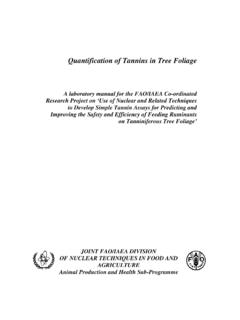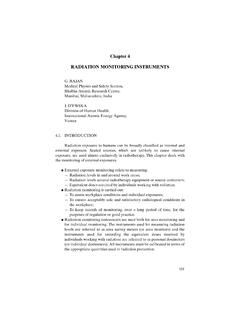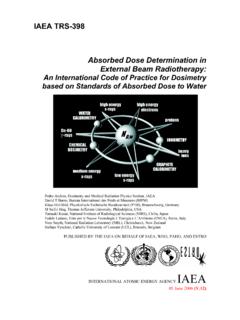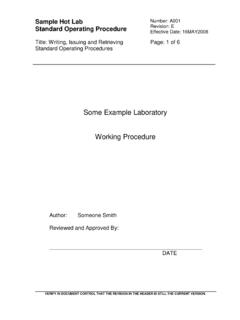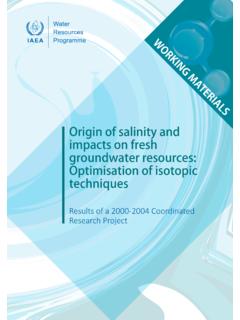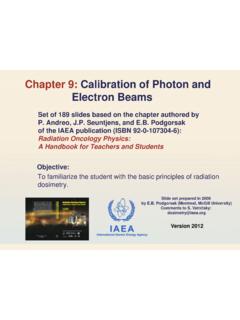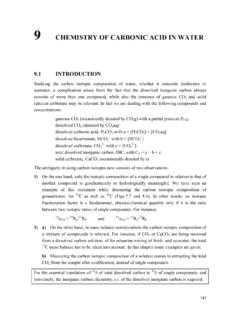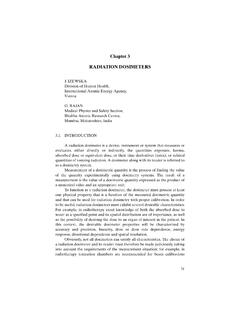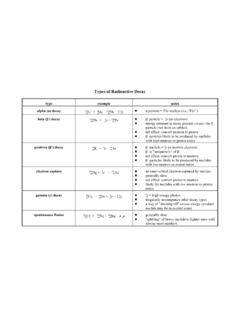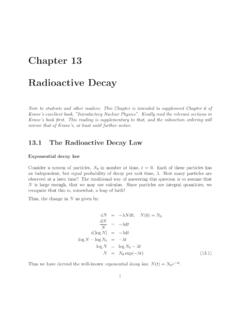Transcription of 6 EQUATIONS OF RADIOACTIVE DECAY AND GROWTH
1 6 EQUATIONS OF RADIOACTIVE DECAY AND. GROWTH . The mathematical expressions presented in this chapter are generally applicable to all those processes in which the transition of the parent nucleus to a daughter nucleus , the process of RADIOACTIVE DECAY , is governed by statistical chance. This chance of DECAY is equivalent to the degree of instability of the parent nucleus. Each RADIOACTIVE nuclide has its specific degree of instability which, as we will see, is going to be expressed by the half-life assigned to this nuclide. The radioactivity of a sample is more complicated if it consists of two or more components, such as: (i) in the case of a mixture of independent activities, (ii) if one specific type of nuclide shows two modes of DECAY , so-called branching DECAY , and (iii) if we are dealing with a nuclear DECAY series in which also the daughter nuclides are RADIOACTIVE .
2 All these phenomena will be discussed separately. LAW OF RADIOACTIVE DECAY . The fundamental law of RADIOACTIVE DECAY is based on the fact that the DECAY , the transition of a parent nucleus to a daughter nucleus is a purely statistical process. The disintegration ( DECAY ) probability is a fundamental property of an atomic nucleus and remains equal in time. Mathematically this law is expressed as: dN = lN dt ( ). and l=. (- dN / dt ) ( ). N. where N is the number of RADIOACTIVE nuclei, -dN/dt the decrease (negative) of this number per unit of time and l is thus the probability of DECAY per nucleus per unit of time. This DECAY constant l is specific for each DECAY mode of each nuclide.
3 The radioactivity or DECAY rate is defined as the number of disintegrations per unit of time: A = -dN / dt = lN ( ). 75. Chapter 6. A. 1000. 800 A0. T1/2. 2T1/2. 600. 400 1/2 A0. 200 1/4 A0. 0. 0 10 20 30 40 50 60 70 80 90 100. time in hours The rate of RADIOACTIVE DECAY . After each subsequent half-life of 20 hours the number of RADIOACTIVE nuclei and the original radioactivity of 800 units are divided into half. By integration of this relation and applying the boundary conditions that at in the beginning t = 0 and N = N0 we obtain: ln(N/N0) = -lt ( ). and subsequently the equation of exponential DECAY : N = N0e-lt ( ). or using : A = A0e-lt ( ). The time during which A0 decreased to A (= the age of the material) is: T = (1/l)ln(A/A0) ( ).
4 The relations of and indicate the rate at which the original number of RADIOACTIVE nuclei (N0) and the original radioactivity (A0) decrease in time ( ). 76. EQUATIONS of RADIOACTIVE DECAY HALF-LIFE AND MEAN LIFE. It is a common practice to use the half-life (T1/2) instead of the DECAY constant (l) for indicating the degree of instability or the DECAY rate of a RADIOACTIVE nuclide. This is defined as the period of time in which half of the radioactivity has disappeared (half of the nuclei have disintegrated, ): T1/2 = (-1/l)ln(1/2) ( ). from which: ln 2 l= = ( ). T1 / 2 T1 / 2. The mean life of a nuclide is the sum of the life times of a certain number of nuclei (before they have all disintegrated) divided by the number of nuclei.
5 During the time interval dt a number of dN nuclei disintegrate. These "lived" during a period t, which amounts to a total life time for dN nuclei of (cf. ): t dN = t lN dt Integrating over all nuclei (N) gives the mean life (time): 1 . -lt t -lt 1 -lt . t= t lN dt = l t e dt = l - e + e dt . N0 0 0 l 0. l0 . ( ). 1 1 1. = l 0 + - e -lt 0 =. l l l As an example, the mean life of a 14C nucleus with T1/2 = 5730 a is 8267 years. Then l =. 1/8267, which means that a sample activity decreases by 1 in about 8 years; a 3H sample activity (T1/2 = a) decreases by per year. ACTIVITY, SPECIFIC ACTIVITY AND RADIONUCLIDE. CONCENTRATION. The activity of a certain sample is the number of a RADIOACTIVE disintegrations per sec for the sample as a whole.
6 The specific activity, on the other hand, is defined as the number of disintegrations per unit weight or volume of sample (see of 14C and 3H, Chapter 8). The unit of radioactivity is the Becquerel (Bq), which is defined as a DECAY rate of one disintegration per second (dps) or the now obsolete Curie (Ci) which was defined as a DECAY rate of 1010 dps. 77. Chapter 6. As an example of the relation between the specific activity of a sample and the actual concentration of the RADIOACTIVE nuclide, we will calculate the specific tritium (3H) activity of water containing one 3H atom per 1018 hydrogen atoms (equivalent to 1 TU = Tritium Unit (Chapter 8): Aspec = lN (per litre). where: l = (ln2)/T1/2 = (ln2) a (1 year = 107 s).)
7 N = 2 x 10-18 (G/M) A (G/M = number of moles). 23. A = Avogadro's number = 10 /mol M = molecular weight = pCi = pico-Curie = 10-12 Curie = 10-2 dps = Bq The numerical result for water with 1 TU of tritium is: Aspec = Bq/L = pCi/L ( ). As another example we can calculate the 14C concentration in carbon, which has a specific 14C. activity of dpm per gram of carbon (in the year AD 1950) (see 14C standard activity, Chapter 8): 14. C 5730 ( 10 7 ) 12. = 23. = 10 -12 ( ). C 60 ln 2 ( 10 ). MIXTURE OF INDEPENDENT RADIOACTIVITIES. shows a semi-logarithmic DECAY curve of a mixture of two activities that are completely independent, a composite DECAY curve. If the half-life values are sufficiently apart, it is seen to be possible to unravel the two separate DECAY curves, starting at the right-hand side of the curve, where the one activity has already disappeared.
8 Subtracting the straight semi-logarithmic curve from the composite curve gives the straight line for the shorter-lived nuclide. BRANCHING DECAY . Also in nature RADIOACTIVE nuclides exist that show two different modes of DECAY . One example is presented by 40K that can DECAY with the emission of a b- or a b+ particle ( ). 78. EQUATIONS of RADIOACTIVE DECAY ln A. 1000. 100. T1/2 = 10 hrs 10. T1/2 = 2 hrs 1. 0 10 20. time in hours Semi-logarithmic plot of a composite DECAY curve for a mixture of two independent RADIOACTIVE compounds with half-lives of 2 and 10 hours. The longer-lived activity can be subtracted from the sum curve (heavy line) to produce the semi-logarithmic straight DECAY curve for the shorter-lived nuclide.
9 Each DECAY mode has its specific DECAY constant or half-life. The total DECAY is simply the sum of both single chances and is thus given by: ltotal = l1 + l2 ( ). and the total half-life consequently by: (1/T1/2)total = (1/T1/2)1 + (1/T1/2)2 ( ). RADIOACTIVE DECAY SERIES. If a RADIOACTIVE nuclide is situated in the Chart of Nuclides far from the stability line (for the light elements at Z=N), the daughter nucleus after RADIOACTIVE DECAY may be RADIOACTIVE as well. In nature this occurs with the heavy nuclides in the uranium and thorium DECAY series (Chapter 12). Here the original DECAY of 238U or 232Th is followed by a series of RADIOACTIVE DECAY products. shows schematically how the elements of such DECAY series are related.
10 79. Chapter 6. Z. a DECAY b DECAY N. Schematic representation of a hypothetical multiple DECAY curve, analogous to the DECAY curves of the U and Th DECAY series ( ). In this context we can restrict ourselves to one element from the multiple DECAY chain: the relation between a parent and a daughter activity. The relations in a second and higher degree have been treated elsewhere (see textbooks by Friedlander et al. and by Faure). The parent nucleus decays according to the EQUATIONS of RADIOACTIVE DECAY which we have treated in this section: dN 1. A1 = - = l1 N 1 ( ). dt and N1 = N10 e - l1t and A1 = A10 e - l1t ( ). The amount of daughter nuclei is determined by two processes: (i) RADIOACTIVE DECAY and (ii).
